Have you ever left an IKEA store thinking you bought much more stuff than you planned? Well, you’re not the only one. Homeware titan IKEA deploys a shopping experience like no other – one in which the vast majority of purchases are impulsive.
The IKEA experience – from the outside of the store to the showroom, to the marketplace, to café, to checkout, to a hotdog for the road – works by following some of the most essential retail psychology rules and breaking others.
Let’s uncover what makes IKEA so good at tricking shoppers to buy more.
How IKEA tricks you into buying more
An analysis by researchers at University College London estimates that 60% of IKEA purchases are impulsive. This means that the majority of the stuff running through the tills is stuff shoppers didn’t know they wanted when they entered the store. What’s more, internally, IKEA believes that up to 80% of purchases defy logic.
But how does IKEA trick us into buying more than we planned? Here are six psychological tricks Ikea uses to make you spend more.
1. The Gruen effect: Ikea maze
Probably the most obvious way IKEA tricks you into buying more is their maze-like store layout. The confusing layout is designed to force you to submit to following an arduous path full of subliminal messages.
With this, IKEA has mastered a psychological principle called the Gruen effect — when the layout of a store is so bewildering that it makes you forget the original reason you came there, leading to impulse buys.
Most other companies use store layouts that give customers the freedom to explore at their own will. In general, retailers design their stores with 3 goals in mind:
- Intelligibility: Easy to understand the floor plan
- Accessibility: Easy to navigate
- A clear visual field: Exposure to products and the lay of the land
However, IKEA breaks all of these rules.
Want to buy a rug? You’re going to have to walk past bedroom furniture, lamps, toilet brushes, and kitchen equipment to get there. This maze-like store layout serves several purposes:
- It forces wider product exposure: At most retail stores, shoppers only lay eyes on around a third of all the items for sale; IKEA’s layout herds customers past its entire product inventory.
- It creates a false sense of scarcity: When you pass by items you’re on the fence about, they’re inclined to just put them in the cart because you don’t want to backtrack through the maze later on.
- It creates a sense of mystery: You can’t see around the next corner, which creates a subconscious sense of mystery and draws you gradually further into the store.
2. Strategic product placement
In addition to the intentionally designed, disorienting store layout, Ikea tricks you with smaller psychological cues during your shopping experience. They make sure you notice all the well-placed, unfeasibly cheap products. Below are a few examples of product placements that lead shoppers to put more items in their trolly:
- Strategically placed mirrors: When you catch a glimpse of yourself in an Ikea showroom, you’re primed to believe you belong in it. This leads you wanting to recreate similar space in your own home.
- Contextual positioning: Each section is designed to mimic real rooms. This makes the rooms to exude a familiarity that customers will find calming and comforting. Familiarity encourages purchasing.
- “Bulla bulla” (dump bins): Products are displayed in a way that makes them look cheap. For example, they fill a bin to the brim with a particular product. This makes customers think that they are making a smart purchase.
3. The Diderot effect
Another intriguing psychology behind how IKEA entices you to spend more is something called the Diderot Effect. This phenomenon describes our tendency to desire additional, complementary items once we acquire something new.
This effect is brilliantly utilised at IKEA through their well-designed showrooms showcasing complete room setups. By immersing you in these stylish displays, IKEA triggers a sense of cohesion and prompts you to buy more than just the main item. You find yourself irresistibly drawn to the perfectly matching accessories, decor, and furnishings.
For example, let’s say you visit IKEA with the intention of purchasing a new bed frame. As you explore the showroom, your attention is captivated by a meticulously designed display featuring a fully furnished and coordinated bedroom. The inviting atmosphere and well-coordinated decor activate the Diderot Effect, sparking a desire for more than just a bed. Suddenly, you find yourself adding matching curtains, decorative pillows, and other complementary items to your shopping cart, driven by the aspiration for a harmonious and stylish bedroom ensemble.
4. Smart pricing tactics
When it comes to pricing, IKEA unsurprisingly has a trick or two on their sleeve.
Firstly, something you’ll likely see at play in IKEA is the decoy effect. This is when a retailer displays a less appealing option to make other products seem like a better deal.
Let’s say there are two different chests of drawers for sale: a £39.99 budget unit, and a £59.99 unit with more premium materials. Ikea might create a third unit — one that offers neither the low price of the budget unit nor the premium materials of the pricier unit — to make the others look better.
A study has found the decoy effect not only boosts sales but can increase the retailer’s gross profit by 14.3%.
Pricing Strategies like this help explain why we buy more stuff once we’re inside an IKEA. But what brings us there in the first place, is often the allure of affordable prices.
Ikea often follows a “price first, design later” philosophy: It starts with a price target — say £6.99 for a new stool — then reverse-engineers the design process to meet that goal. Because competitive pricing is one of IKEA’s main selling points, many of the company’s products actually get cheaper over time.

4. The IKEA effect
Among behavioural scientists, IKEA is so known for the psychological tricks it employs that they have even named a psychological phenomenon after it. This IKEA effect is a cognitive bias where we place a higher value on items we build ourselves, regardless of the quality of the end result. In other words, labour leads to love.
The Harvard Business School researchers described the experiment that gave the IKEA Effect its name this way:
“Two groups were given IKEA boxes, with one group given fully-assembled versions, and the other given unassembled boxes, which they were told to put together.
This second group were willing to pay much more for their box during the subsequent bidding process than those with pre-assembled boxes.”
The idea of having to assemble flat-pack furniture sounds annoying to many. But the reality is that IKEA’s furniture building model likely contributes to, rather than inhibits, overall sales.
6. The secret psychology of meatballs
Did you know that IKEA sells more than 1 million meatballs globally? The meatball is something of a classic at IKEA stores. People love them, not to mention the food at IKEA in general. In fact, it reels in around $2.24 billion in food sales per year (~5% of its overall revenue).
At first glance, it might not seem like IKEA’s food has an effect on their furniture sales. But according to the company’s research, 30% of its shoppers come to the stores just to eat.
The food at IKEA doesn’t only have an impact on food sales. It also has a priming effect on how customers think, feel, and act in the store. Eating primes a state of happiness, and that mood can affect how much customers spend and what they buy.
In a 2012 study, a survey of 700 shoppers found that those who ate at the food court spent an average of more than 2x more on home furnishings than those who didn’t.
Related: How drinking coffee before shopping makes you spend more
7. Sense of commitment
Just when you’re about to embark on your IKEA-maze journey, you meet a dispenser of pencils and empty shopping lists. With so many products and corresponding storage places, this memory aid comes in handy. How thoughtful of IKEA!
While this is surely helpful for the shoppers, there’s a stronger principle at play: commitment. By clearly writing down what you want to buy, you’re committing yourself to this purchase, whether you need it or not.
Summary: IKEA psychology tricks
- Its in-store maze design is a “submissive experience”, in which shoppers are taken through the entire product catalogue. Exposure to more products makes you buy more.
- IKEA shows many items in a context of an actual room to trigger familiarity (if you can imagine using a product, you are more likely to buy it). They often do this with a lot of mirrors so that you see yourself (and your family) in the rooms.
- Pricing is what brings people to IKEA, but once there it uses techniques like decoy prices to encourage buyers to choose more profitable options.
- Food courts are essential: IKEA shoppers that eat in the in-store restaurant spend close to double what non-eaters spend.



I agree IKEA is definitely a giant maze. I did not like the experience. For me, I did not feel like buying more rather it led to a more dislike of the company. Thank you for sharing this article. 😊
Pastor Natalie (ExamineThisMoment)
letstakeamoment.com
IKEA is one giant maze, and their psychology tricks work. I seem to always leave with more than I planned.
This is much familiar in any supermarket brand, amazing post
full of details..